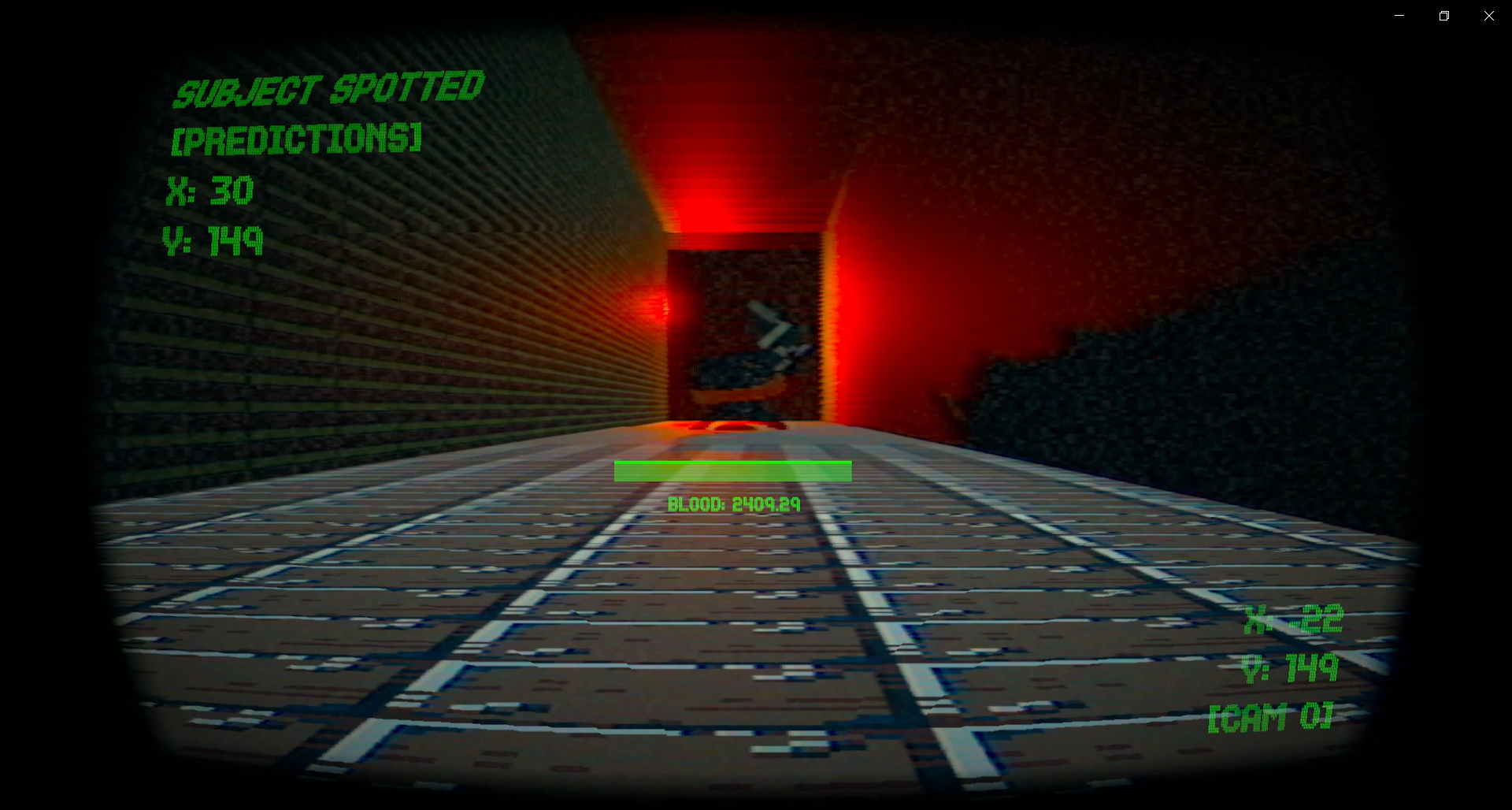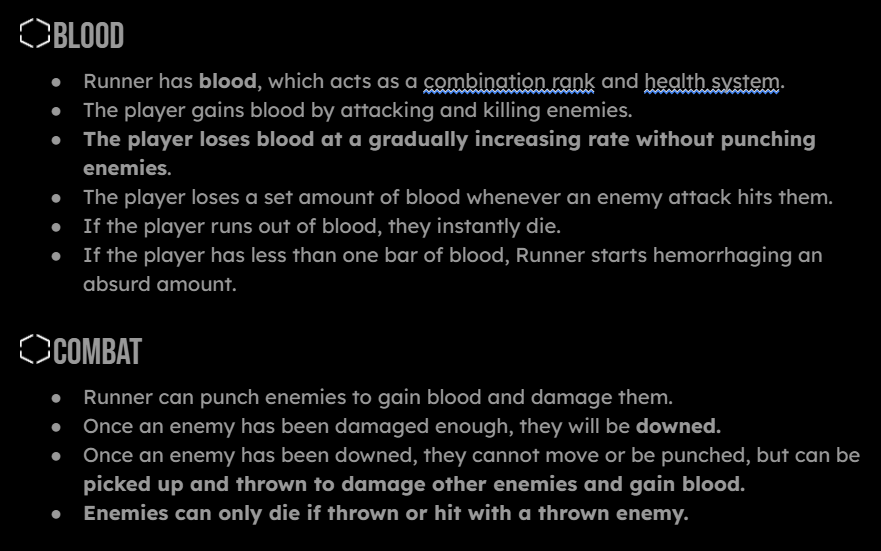
DESIGN PROCESS
Before starting vertical slice development, I met with my partner to discuss the trajectory and vision for the project. We considered the feedback we’d gotten and everything we’d learned from our ideation prototypes to decide on a direction and carefully scope out the game. This gave us our experience goals and sources of truth we used throughout development.
We developed our vertical slice concentrically, spending the first sprint nailing down compelling movement and camera systems as our primary mechanics. We took this time to refine our controls from the very beginning and learn how players would react to different environments and camera angles.
MACRO AND GDD
VERTICAL SLICE
My second sprint was spent implementing secondary mechanics, including combat features and the blood system. We also drafted part of our level and diegetic user interface. Above is an earlier version…
The final version of the vertical slice added the finalized blood system, enemy attacks and aggro, and tertiary mechanics like the sniper sequence.
I built out more of the level and implemented more combat sequences as dictated in our macro to create a section we could reference in building out the rest of the game throughout development.
…followed by a tuned and dressed version used for in-class playtesting and feedback.
ALPHA
BETA
The alpha build of BLEED RUNNER made up the bulk of work on the game and had a clearly defined creative direction.
I built out our entire level based on our macro, with all associated encounters, sequences, menus, and features implemented. In response to player feedback, we added an extended onboarding sequence to the game before the player character starts bleeding, which we storyboarded ahead of time.
We also revised UI and some camera placements to give a clearer indication of player blood level, added all special sequences including the final combat encounter and the ending, implemented visual effects like screenshake and hitstop for game feel, added gamepad support, and began our collaboration with Berklee, implementing our ambience, music, and adaptive audio functionality to create a full soundscape.
Our beta build focused on polishing what we’d made in alpha and addressing player usability concerns discovered in our first formal/external playtest with the alpha build.
I added slowdown on the death event, UI for activating checkpoints, additional narrative elements like environmental monitors and a torture chamber, revised camera placements, a revised ending sequence, and full level set-dressing. BLEED RUNNER became a smoother, more polished experience while staying true to our experience goals.
During our beta playtest, players were able to intuitively understand the blood system, objective, and narrative. Players were able to progress through the game with persistence, even when inexperienced with games or facing challenging sections, and a variety of alternate strategies emerged for each player’s play style.
THE FINAL PRODUCT
-

Project Production and Iteration
BLEED RUNNER was developed under a concentric agile framework, moving from an experimental ideation phase to iterative vertical slice, alpha, beta, and gold master deliverables. We prioritized implementing and polishing primary, secondary, and tertiary mechanics throughout development to make a varied, compelling, and feasibly scoped product.
I collaborated with another designer and a 5-person audio team from Berklee College of Music to iterate on our concept and respond to feedback from rigorous formal playtesting, all the while keeping us on track for release. We also received guidance and feedback from Riot Games developers such as professors Aaron Cheney and Paul Bellezza as well as NeoBards Creative Director Al Yang.
Builds and audio were submitted and reviewed weekly, with each production milestone accompanied by a presentation for a brain trust of other developers to respond to. Throughout development, we held to our macro with changes as needed and avoided scope creep. -

Combat Design
I designed and engineered BLEED RUNNER’s combat system, prioritizing simplicity and readable feedback to create a sense of power and reward. On top of designing the enemy aggro and attack UI, I also created and implemented the blood and spark particle effects used to reward players and indicate damage throughout the game.
Enemy AI is intentionally simple, encouraging players to play aggressively and lure enemies into later areas. Encounters are spaced to complement the main blood system, providing breaks from the tension as players can regain their blood and experiment with multiple attack types.
Players are given a variety of potential strategies with punch and grab/throw affordances, including throwing enemies at each other, holding and pummeling enemies, crowd-controlling with large environmental props, and outright punching as fast as possible without needing to kill all enemies.
All combat and movement mechanics were finalized prior to our Vertical Slice deliverable. -

Level Design
My primary goals with BLEED RUNNER’s level design were mood, navigability, and progression.
Since the player is constantly on the clock, platforming challenges are sparsely laid out. Lighting and set-dressing are the main focus, creating a compelling environment and atmosphere with few unique assets.
A staircase roughly two thirds of the way through the game is the most tense platforming sequence, but players are introduced to an easier version of it during the onboarding sequence. The later of the two stairway sequences leads into another location where the player avoids being shot by a sniper, making a large open space into a threatening set piece.
Other set pieces, like the hallway to the final room and a torture chamber the player passes in the onboarding sequence, help convey the narrative in an unintrusive and cohesive way. -

Level Design - Camera
I worked off of preliminary storyboards and references such as Devil May Cry and Silent Hill when laying out BLEED RUNNER’s cameras to create a fluid action game experience from the view of a CCTV camera.
Combat encounters take place in straightforward camera views for ease of play, with more elaborate or striking angles used for environmental exploration.
The camera system alternates between static viewpoints and tracking viewpoints for usability.
Inspired by the cinematic 180 Degree Rule, BLEED RUNNER camera transitions follow what I call “The 90 Degree Rule“ - at no point does a camera angle change by more than 90 degrees, so as not to disrupt the player’s control when moving in a given direction. -

Sound Design
I handled all audio implementation for BLEED RUNNER, including sound effect editing and mixing, audio scene hierarchy and layout, dynamic audio implementation for combat encounters, ambience and music trigger implementation and placement, communicating with our audio team at Berklee, and many of the sound effects present in the final game.
The soundtrack of BLEED RUNNER and its implementation prioritize a sense of immersion outside of combat encounters, using ambience and music to ground the game’s setting.
The sound effects balance immersion with functionality, feeling right for the character and acting as distinct, legible assets that reward play. -

User Experience Design
BLEED RUNNER’s experience design was informed by a formal playtesting process. My partner and I took notes during testing sessions, compiling tester behavior, comments, and feedback in a centralized document and using a uniform survey and script to collect tester experience data.
I implemented telemetry into our project, giving clear readouts of player punches, throws, deaths, pummels, and ally kills for each test.
BLEED RUNNER’s controls were tested on keyboard, Xbox One gamepad, and PlayStation 4 Dualshock gamepad, with control prompts and bindings dynamically updating during play based on the control scheme being used. Keyboard controls also include a two sets of bindings to better accommodate left-handed players.

